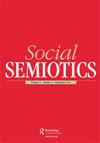Multimodal metaphor (re)framing: a critical analysis of the promotional image of China’s Hubei Province in the post-pandemic era on new media
IF 1.2
2区 文学
Q2 COMMUNICATION
引用次数: 0
Abstract
This study presents multimodal metaphors as (re)framing tools in the analysis of a 10-minute promotional video of Hubei Province produced by the Chinese government and circulated on new media platforms like YouTube, Douyin (Chinese Tik Tok) and WeChat Channels. The video introduces Hubei Province to the world in the pre-pandemic, pandemic and post-pandemic stage to erase the prejudiced “Wuhan virus” and “China virus” painted by Western media. Drawing upon MIPVU (the Metaphor Identification Procedure Vrije Universitei), multimodality of metaphors, and Critical Discourse Analysis (CDA), this study analyzes how the Chinese government attempts to reframe Hubei as a place of courage, prosperity and humanity via metaphors like WAR, BRIDGE, HAND and BACK. The benefits and drawbacks of such metaphor usage are also discussed with appropriate contextual and socio-cultural relevancies. The study provides a hands-on practice of the CDA-based analysis of multimodal metaphors and justifies the feasibility of integrating translation, metaphor and semiotic studies through the sociological theory of framing. [ FROM AUTHOR] Copyright of Social Semiotics is the property of Routledge and its content may not be copied or emailed to multiple sites or posted to a listserv without the copyright holder's express written permission. However, users may print, download, or email articles for individual use. This may be abridged. No warranty is given about the accuracy of the copy. Users should refer to the original published version of the material for the full . (Copyright applies to all s.)多模态隐喻(再)框架:后大流行时代中国湖北省新媒体宣传形象的批判性分析
本研究将多模态隐喻作为(重新)框架工具,分析了一段由中国政府制作并在YouTube、抖音和微信频道等新媒体平台上传播的湖北省10分钟宣传视频。视频向世界介绍了疫情前、疫情中和疫情后阶段的湖北省,以抹去西方媒体所描绘的带有偏见的“武汉病毒”和“中国病毒”。本研究借鉴了武汉大学的隐喻识别程序MIPVU、隐喻的多模态性和批判性话语分析(CDA),分析了中国政府如何试图通过战争、桥梁、手和背等隐喻将湖北重塑为一个充满勇气、繁荣和人性的地方。这种隐喻用法的优点和缺点也与适当的上下文和社会文化相关性进行了讨论。本研究提供了基于CDA的多模态隐喻分析的实践,并通过框架的社会学理论证明了整合翻译、隐喻和符号学研究的可行性。[发件人]《社会符号学》的版权归Routledge所有,未经版权持有人明确书面许可,不得将其内容复制或通过电子邮件发送到多个网站或发布到listserv。但是,用户可以打印、下载或通过电子邮件发送文章供个人使用。这可能会被删节。对复印件的准确性不作任何保证。用户应参考材料的原始发布版本以获取完整信息。(版权适用于所有人。)
本文章由计算机程序翻译,如有差异,请以英文原文为准。
求助全文
约1分钟内获得全文
求助全文

 求助内容:
求助内容: 应助结果提醒方式:
应助结果提醒方式:


